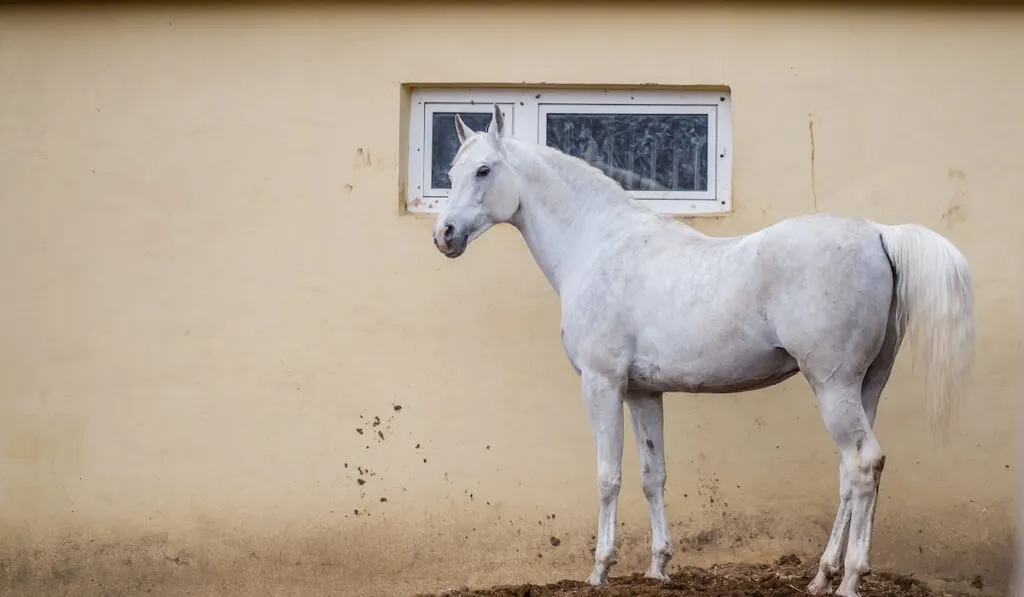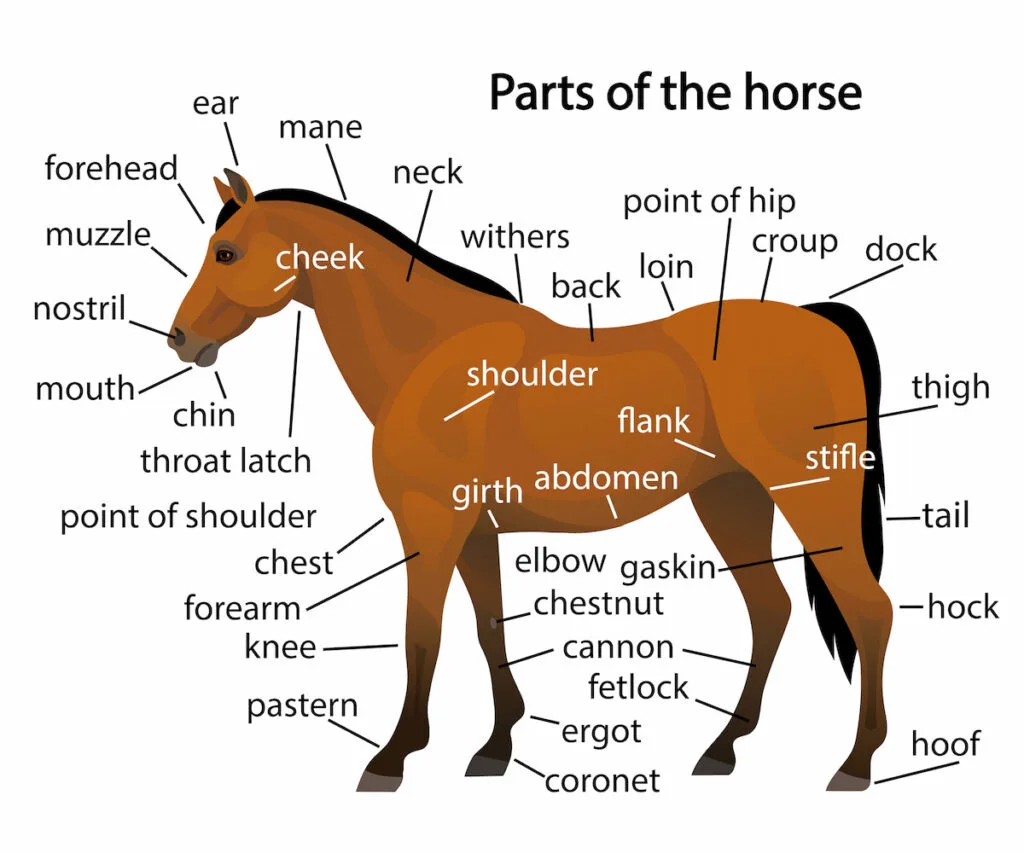Equine anatomy is very important for many reasons, aside from being a knowledgeable horse person or horse owner being able to describe the correct piece of anatomy and location is vital when speaking with a vet and describing injuries or potential injuries.

Directional Terms
When covering equine anatomy, it is important to understand some directional terms first:
- Fore – Toward the front of the horse, meaning the head of the horse.
- Rear (hind) – Toward the back of the horse, meaning the tail
- Inside – Toward the middle or belly of the horse. On the right side of the body, this means the left and on the left side of the body it means the right.
- Outside – Away from the middle of the horse. On the right side of the horse, this means right and on the left side of the body, this means left.
Head to Toe Anatomy

- Poll – The area between the horse’s ears. This is often referenced when talking about headgear and the leverages of different bits.
- Forelock – The portion of mane that falls between the horse’s ears and onto the “forehead” of the horse. This is often styled or managed differently depending on the horse’s breed or discipline.
- Muzzle – The area surrounding the nostrils and mouth. A change of skin and hair texture can be seen in this area.
- Chin – The soft rounded portion of the horse’s face below their mouth. This is often referred to in fitting bridles and curb straps.
- Jaw (jowl) – Underside of the horse’s head including the large rounded area where the horse’s head meets the neck.
- Ears – The external area of the ears sits on top of the horse’s head and can swivel to locate and pick up sound. This area is an important indicator of a horse’s body language and behavior.
- Crest – Top of the horse’s neck where the mane begins to grow. This area is referenced in discussions about collection and monitoring a horse’s body fat and condition scoring.
- Mane – The length of hair growing from the top of the horse’s neck. This is trimmed to different lengths and managed differently depending on breed and competition style.
- Jugular Groove – The small groove along the underside of the horse’s neck extending on the left side from the jaw down toward the shoulder. This area is important for locating the jugular to take a pulse or give intravenous injections.
- Withers – The bony ridge where the neck and back meet on top of the horse’s shoulder. This is the area where a horse’s height is measured.
- Back – The top of the horse’s midsection where saddles and riders are carried.
- Barrel – The rounded middle section of horse where the ribcage is located.
- Flank – Where the barrel meets the horse’s hind leg. Often a change in the direction of the hair can be seen here. This area is especially sensitive on most horses.
- Loin – This area can be considered the horse’s “lower back”. The loin is the muscle group where the back and hind end meet.
- Croup – The high point and slope of the horse’s hind end behind the loin. The exact location can be found by locating the bony structure on top of the horse’s hind end. The angle of this slope is often discussed in discipline suitability and conformation.
- Point of Hip – The bony protrusion above the flank and below the croup. This will often be the widest part of the body.
- Dock – The area where the tail meets the body and ties into the hind end of the horse.
- Tail – Both the bone structure and hair on the hind end of the horse. Tails are (like manes) treated and styled differently depending on breed and discipline. Tails are also vital in horses deflecting insects and displaying body language.
- Shoulder – The large group of muscles immediately below the withers and in front of the barrel.
- Point of Shoulder – The bony foremost location on the horse’s shoulder. This location is important when measuring for blankets or other equine outerwear.
- Point of Buttock – The furthest rear point of the horse’s hind end near the dock. This is the other location to measure when fitting a blanket. The distance from the point of the shoulder to the point of the buttock is roughly the size blanket a horse will wear.
- Chest (Breast) – Area on the front of the horse between the shoulders and immediately under the neck. As much blood flows here, this area is important to keep a cold horse warm or cool off a horse that is hot or overheating.
- Girth (Heart Girth) – The area immediately behind the front leg. This area is where the girth or cinch should fit when the horse is saddled.
- Elbow – The bony point on the rear side of the front leg near the girth on the bottom side of the shoulder.
- Forearm – The area of muscle that extends down from the bottom of the horse’s shoulder to its knee.
- Knee – The forelimb joint that connects the upper and lower areas of the front leg. This joint consists of many small bones and is very similar in structure to the human wrist. There are no muscles on the horse’s front leg below this joint. Below the knee, the horse’s leg consists of soft tissue and bone.
- Cannon – The cylindrical bony length of limb that extends from below the knee to the next joint (the fetlock). This area can be measured to estimate mature height in young horses and is important to measure when fitting performance or protective boots for a horse.
- Fetlock – The joint at the lower end of the cannon connecting the cannon and pastern. This area is a mass of soft tissue and bone. Lameness issues and soft tissue injuries are common in this joint.
- Pastern – The short length of bone that connects the horse’s fetlock to the hoof. The angle of the pastern is often discussed in conformation and event suitability.
- Coronet – The band at the top of the hoof where hair quits growing. This area is extremely sensitive to horses and a small bump on this area can cause short term lameness.
- Hoof (foot) – The keratin structure at the end of a horse’s legs. An old proverb states “No hoof, no horse” as the hoof and hoof care are vital to horses’ comfort, soundness, and longevity.
- Wall – The external area of the hoof that can be seen while the hoof is on the ground. When the hoof is picked up, you can see the line of the hoof wall around the perimeter of the sole of the hoof.
- Sole – The bottom “flat” area of the hoof
- Frog – a “V” shaped structure on bottom of the hoof that is soft and has crevices along either side of it.. It extends from the back of the hoof and ends approximately ⅔’s of the way across the hoof. This acts as a cushion for the horse as it travels. Frog health is important to horse soundness.
- Bars – The portion of hoof that runs along the outside of the frog.
- Toe – The front portion of the hoof that faces toward the head.
- Heel Bulbs – The two bulbous structures on the back of the hoof underneath the pastern.
- Ergot – A small, keratin growth on the back and underside of the horse’s fetlock. Typically, this is protected or covered by hair, but can easily be located.
- Chestnut – A quarter-sized growth on the inside of the horse’s forearm above the knee. This will flake and fall off naturally. Farriers can also help maintain these growths during regular hoof maintenance.
- Stifle – Below the flank where the hind leg meets the barrel. This joint is structurally equivalent to a human knee. Within this joint is the patella (kneecap) that can “lock” allowing horses to sleep while standing up.
- Gaskin – The area of muscle connecting the stifle and the hock on the hind leg. Along the backside of the gaskin is the horse’s Achilles tendon.
- Hock – This hind joint is equivalent to the human heel and connects the gaskin to the hind cannon. This joint is often discussed in lameness exams and is regularly radiographed in performance horses.
When shopping for tack or anything you may put on your horse, being able to locate body parts for an accurate measurement will ensure a good, safe, and healthy fit.

